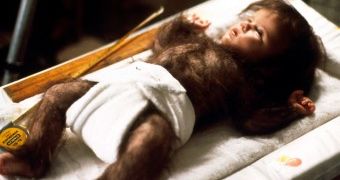1 %. This makes the DNA difference between you and a chimp. But I guess a chimp female is not a very hot image for a male human (actually... who knows!?). As for male chimps... at least are too short...
Today, there are 5 species of apes: two species of orangutans, one of gorillas, and two of chimps (common and lesser or bonobo), but chimps have the closest DNA to the human one: 99 %. Beyond ethical reasons, could a viable human-chimp result in case of a crossed mating?
Humans have 23 pairs of chromosomes, chimps have 24. Thus, even if the resulting hybrid would be viable, it would be sterile.
This is exactly the case of mules and hinnies, a hybrid between a horse mare and a donkey stallion or a donkey mare and a horse stallion. Donkeys have 62 chromosomes, whereas horses have 64. These hybrids have 63 chromosomes which cannot evenly divide, to form healthy sex cells. Still, isolated cases of fertile mules have been signaled.
Thus, a human-chimp hybrid would be sterile, as it would have 47 chromosomes. But the story does not stop here. Today's humans do not breed with chimps, but apparently, our ancestors have done it, based on archaeological and DNA data.
DNA analysis shows that we completely split off from the chimps 4-5 million years ago. But Sahelanthropus, a 7 million years fossil, believed to be one of our ancestors, is much more human-like than 4-3 million years old human species.
Our early ancestors appeared to have interbred with chimpanzees after the two species drew apart millions of years ago, explaining the amazingly recent divergence hominids - chimps, of just 4 million years, as showed by the mithocondrial DNA, used to calculate the molecular clock (the speed at which genes mutate, thus the evolution's rhythm).
Archaeological data indeed sustains the hypothesis that humans and chimpanzees separated first 6.5 to 7.4 million years ago. Moreover, "speciation" of chimp and hominid - the process by which they emerged as separate species - took an extraordinary long time: around four million years in all.
Sahelanthropus is older than the date of definitive separation between humans and chimps, yet it is more human than it should be. "The fact that it has human-like features suggest that human-chimp speciation may have occurred over a long period with episodes of hybridisation (inter-breeding) between the emerging species. That such evolutionary events have not been seen more often in animal species may simply be due to the fact that we have not been looking for them," said David Reich from the Broad Institute of Harvard.

 14 DAY TRIAL //
14 DAY TRIAL //